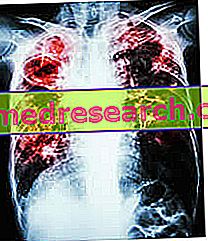Generality
Interstitial disease is a serious pathology of the lungs, characterized by an inflammatory process of the pulmonary interstice often accompanied by its replacement with scar tissue.

The typical symptom that characterizes all types of interstitial disease is dyspnea, or shortness of breath.
Unfortunately, in most cases, interstitial diseases are chronic and irreversible pathological conditions. The treatments, in fact, have limited effects, reducing only the symptoms or slowing down at most the progression of the disease.
Interstitial disease is also known as interstitial lung disease, diffuse infiltrative pneumopathy, interstitial lung disease or ILD (from Interstitial Lung Disease )
Short reference on the pulmonary alveoli
The alveoli, more correctly called pulmonary alveoli, are small cavities of the lungs in which gas changes occur between the blood and the atmosphere. Inside the alveoli, in fact, the blood is enriched with the oxygen contained in the air breathed and is "freed" of the carbon dioxide discarded by the tissues, after their spraying.
The alveoli reside at the end of each terminal bronchiol; the terminal bronchioles are among the last branches of the airways, which begin with the nasal cavities and continue with nasopharynx, pharynx, larynx, trachea, primary bronchi, secondary bronchi, tertiary bronchi, bronchioles and, precisely, terminal bronchioles.

Figure: the alveoli are small air chambers, similar to small bags. They are located at the ends of the terminal bronchioles, that is the final branches of the bronchi.
The airways are didactically divided into upper airways (from the nasal cavities to the larynx) and into the lower airways (from the larynx to the alveoli).
What is interstitial disease?
Interstitial disease is the medical term used to indicate a group of serious lung diseases, characterized by inflammation of the lung interstitium and, often, also by its replacement with scar tissue .
The pulmonary interstitium is the connective tissue that is interposed between the alveoli, guaranteeing the latter the support they need for gas exchange. In fact, the alveolar blood vessels (those that allow the blood to be charged with oxygen), the alveolar epithelium, the basement membrane and the perivascular and perilymphatic tissues "rest" on the pulmonary interstitium.
If they could not count on a healthy pulmonary interstice (such as when scar tissue is formed), the alveoli would be unable to provide proper oxygenation of the blood, thus inducing the appearance of respiratory problems.
SYNONYMS OF INTERSTIZIOPATIA
The word intersticeopathy literally means interstitial disease.
In our body, there are many types of interstices, not only the pulmonary one. However, the pulmonary one is the most well-known from the pathological point of view, therefore the term interstitial disease immediately recalls a problem in the lungs.
That said, interstitial disease is also called: interstitial lung disease, interstitial lung disease, interstitial lung disease or diffuse infiltrative pneumopathy,
INTERSTIZIOPATHY AND PULMONARY FIBROSIS
Intersticesopathy and pulmonary fibrosis are two fairly similar conditions. In general, the first is considered the prelude of the second: when the interstitial lung disease is at an advanced stage and presents with numerous areas of scar tissue, doctors prefer to talk about pulmonary fibrosis.
"Fibrosis", "fibrous tissue" and other similar words are all terms that refer to the presence of scar tissue.
Causes
In general, when damage occurs at the level of the pulmonary interstice, the human organism triggers an ad hoc repair system, which provides to fix the lesion (s).
Interstitial diseases arise when this repetitive stimulated restorative system begins to function inadequately and, first, inflames the damaged pulmonary interstice and, later, replaces it with thick scar tissue.
All this, as we have said, causes a worsening of the alveolar function. In fact, the alveoli involved, being surrounded by a less elastic and more voluminous (or thickened) tissue, are no longer able to "load" effectively the blood with the necessary oxygen.
WHAT CAN 'CAUSE THE MALFUNCTION OF THE REPAIR SYSTEM?
Several factors or circumstances can determine the onset of an interstitial disease. The best known are:
- Long exposure to toxic and polluting substances . This involves repeated damage to the lung, to the point that the repair system becomes ineffective.
The toxic substances and the pollutants responsible are:
- Silica powder. For more information on this, it is advisable to consult the article dedicated to silicosis .
- Asbestos fibers (or asbestos ). Prolonged contact with asbestos can cause the appearance of a generally lethal morbid condition called asbestosis .
- Wheat powder . Farmers are very exposed.
- The dung of some animals, birds in particular .
- Radiotherapy, practiced during the treatment of a lung tumor (lung cancer) or breast cancer (breast cancer). The appearance of scar tissue can occur even after many months, if not years, from the conclusion of radiotherapy treatments. The severity of the lesions (hence the extent of scar tissue) depends on:
- The duration of radiotherapy . The longer it has been, the more likely it is that the consequences will be severe.
- The amount of radiation received . Some radiotherapy treatments can be very short, but very intense from the point of view of the radioactive charge.
- If, together with radiation therapy, chemotherapy has also been practiced.
- The pre-existence of other lung problems .
- Taking certain medications . The incriminated medicines include:
- Some chemotherapy drugs . Used for the treatment of tumors (NB: they affect rapidly growing cells, such as tumors), can cause numerous lung damage. From this point of view, the most dangerous chemotherapists are methotrexate and cyclophosphamide.
- Some antiarrhythmics . Among the drugs used to treat cardiac arrhythmias, amiodarone and propranolol have been shown to be harmful to the health of the pulmonary interstitial space.
- Some antibiotics . Among the medicines for the treatment of bacterial infections, those associated with interstitial disease are: nitrofurantoin, bleomycin and sulfasalazine (or salazosulfapiridine).
- The presence of an autoimmune disease . People with an autoimmune disease have an immune system that works improperly, attacking and damaging (in some cases even deeply) healthy tissues and organs. Among the autoimmune diseases associated with interstitial disease, include:
- Systemic lupus erythematosus
- Rheumatoid arthritis
- Sarcoidosis
- Scleroderma
- Some viral, bacterial or fungal infections . An alteration of the pulmonary interstice may occur after the appearance of: tuberculosis, atypical pneumonia (or mycoplasma pneumonia), Pneumocystis jirovecii pneumonia, chlamydia (induced by Chlamydia trachomatis ) or respiratory syncytial virus infection.
Physicians define an infectious disease, which causes interstitial disease, with the term interstitial pneumonia .
IDIOPATHICAL INTERSTIIA

In these situations, there is also talk of idiopathic interstitial disease or idiopathic pulmonary interstitial disease .
In medicine, the term idiopathic, associated with the name of a pathology, indicates that the latter has arisen for unknown or unidentifiable reasons.
The list of idiopathic interstitial diseases includes:
- Idiopathic pulmonary fibrosis
- Hamman-Rich syndrome
- Antisynthesis syndrome.
RISK FACTORS
The analysis of numerous clinical cases has allowed doctors to establish a list of the possible risk factors for interstitial diseases.
To this list of favoring factors belong:
- Adulthood. Adults from middle age onwards suffer the most from interstitial disease, although it should be pointed out that children can also develop lung interstitial disease.
- Work activities in which exposure to toxic substances and pollutants capable of damaging the lung interstice is inevitable. Miners, farmers, construction workers, potters, etc. are at risk.
- Cigarette smoke. The researchers noted that interstitial diseases are very common in the smoking population, therefore they believe that there may be a link (not yet scientifically proven) between cigarette smoking and interstitial lung disease.
- Previous radiotherapy and / or chemotherapy treatments, for the reasons mentioned above.

- Gastroesophageal reflux disease. Researchers have observed that people with chronic acid reflux are more likely to develop interstitial disease.
Symptoms and Complications
The most common symptom of interstitial diseases is dyspnea (or shortness of breath ).
In general, this disorder worsens with time: from mild to early, it becomes very evident and limiting for the patient, in an advanced stage.
Another fairly frequent clinical manifestation (but still less than dyspnea) is dry cough ( dry cough ).
TEMPORARY INTERFACES AND CHRONIC INTERSTIATIOUS
In most cases, interstitial diseases are chronic and irreversible diseases, as they are sustained by a permanent alteration of the pulmonary interstitium.
Rarely, however, can they also be temporary conditions, in which interstitial damage is slight and potentially reversible (if properly treated).
Typically chronic and irreversible interstitial diseases are those that arise due to long exposure to toxic / polluting substances or those that appear in association with autoimmune diseases; while interstitial diseases generally of a temporary nature are those due to an infectious viral, bacterial or fungal disease (the so-called interstitial pneumonia).
From a symptomatological point of view, temporary interstitial diseases differ from chronic ones due to the rapidity with which the symptoms appear: if in the second the dyspnea takes months or years to become more and more pronounced, in the first it can make its appearance within a few hours or days.
WHEN TO REFER TO THE DOCTOR
In the first respiratory problems, people conscious of belonging to a category at risk of interstitial disease should immediately contact their doctor, for a deepening of the situation.
With regards to chronic and irreversible diseases, like most interstitial diseases, it is worth remembering that the sooner they are identified, the less their negative impact on health.
On the contrary, a late diagnosis can be the cause of many complications.
COMPLICATIONS
A prolonged situation of pulmonary interstitial disease can lead to the onset of serious complications, such as pulmonary hypertension, pulmonary heart and respiratory failure.
Deepening on the complications |
Pulmonary hypertension is the pathological condition in which there is a prolonged rise in blood pressure inside the pulmonary arteries (ie the arterial vessels that carry oxygen-poor blood to the lungs) and the right cavities of the heart. In the presence of an interstitial disease, the pressure increase depends on the compression that the scar tissue exerts on the alveoli and on the small alveolar vessels (or alveolar capillaries). Pulmonary hypertension is a very serious problem, which tends to worsen over time and which can lead to death. |
The pulmonary heart is a very serious heart disease, induced by pulmonary hypertension and characterized by a morphological alteration (enlargement and, sometimes, thickening of its walls) of the right ventricle of the heart (NB: the right ventricle is the contractile cavity of the heart which pumps blood into the arteries directed to the lungs, or the pulmonary arteries). Pulmonary heart onset generally leads to worsening dyspnea. |
Finally, respiratory insufficiency is a severe morbid condition, in the presence of which marked deficiencies of breath and very poor blood oxygenation (hypoxemia) are observed. Usually, it represents the final stage of interstitial diseases. |
Diagnosis
The diagnostic procedure, in order to identify an interstitial disease, requires a fair number of exams and tests.
It usually begins with a thorough physical examination and continues with diagnostic imaging tests and with others for the assessment of lung function; therefore, it concludes with a pulmonary biopsy, a practice that is somewhat invasive but also very reliable and precise in its results.
EXAMINATION OBJECTIVE
During the physical examination, the doctor visits the patient, having the symptoms described by the latter and auscultating the chest with a stethoscope.
DIAGNOSTICS FOR IMAGES
In case of suspected interstitial disease, diagnostic imaging tests usually envisaged are: chest radiography ( RX-thorax ), CT scan (or computerized axial tomography ) and echocardiogram .
RX-thorax and CT use ionizing radiation to report, on a plate, the main anatomical structures of the chest (heart, lungs, etc.). Between the two, the TAC provides images of superior quality; on the other hand, however, it exposes the patient to a higher dose of harmful radiation.
The echocardiogram is an ultrasound examination, which shows the heart and allows us to analyze its state of health. The doctors use them when they are afraid that the condition known as the pulmonary heart has been established.
TEST FOR FUNCTIONALITY ASSESSMENT? PULMONARY
The tests for the evaluation of pulmonary function are: spirometry, oximetry and stress test.
Quick, practical and painless, spirometry measures the inspiratory and expiratory capacity of the lungs; furthermore, it provides information regarding the patency (or opening) of the pulmonary airways.
Oximetry is the measurement of oxygen saturation in the blood. As simple and immediate as spirometry, for its execution you need an instrument called an oximeter, which is applied to a finger or to one of the two ear lobes.
Finally, the exercise test consists of recording how the heart's rhythm, blood pressure and patient's breathing vary, while the latter is practicing more or less intense physical activity.
PULMONARY BIOPSY
Lung biopsy consists of taking and analyzing in the laboratory a small sample of lung tissue, provided by the patient.
The withdrawal can be done through:
- Bronchoscopy . It involves the use of an instrument called a bronchoscope; sometimes, the sample taken may be insufficient in size to an appropriate analysis.
- Bronchoalveolar lavage . It also foresees the use of the bronchoscope, but with slightly different modalities. The sample taken could be of insufficient size.
- Surgery . It is a bloody and invasive procedure, but, from the point of view of results, it is the diagnostic method that guarantees the greatest number of useful information.
Treatment
The possibilities of treatment depend on the form of interstitial disease.
In fact, while temporary interstitial diseases (such as interstitial pneumonia) are treatable and reversible, chronic interstitial diseases are conditions from which it is impossible to heal and which often tend to progressively worsen.
Therefore, if for the first there are treatments that allow the pulmonary interstitium to heal, for the latter the only therapies that currently exist are the symptomatic ones (NB: symptomatic means that they improve the symptomatology and, sometimes, they also slow down the progression of the disease ).
Moreover, previously, it was stated that in chronic and irreversible interstitial diseases the alteration of the pulmonary interstice is permanent.
Turning to real therapies, as regards temporary interstitial diseases, there are ad hoc drugs, which fight the cause and solve the problem; as far as chronic and irreversible interstitial diseases are concerned, there is the possibility of using medicines, oxygen therapy, respiratory rehabilitation sessions and, in extreme cases, surgery.
DRUGS FOR TEMPORARY INTERSTIZATIOS
Since the most common temporary interstitial diseases are interstitial pneumonias, in this sub-chapter we will exclusively discuss the therapies provided for in these circumstances.
If the cause of the disease is a bacterium, doctors must use antibiotics, in this case azithromycin and levofloxacin.
If the cause is a fungal infection, the treatment consists of administering an antifungal drug based on trimethoprim and sulfamethoxazole.
Finally, if the triggering factor is a viral infection, an active surveillance of the infection is expected, waiting for it to heal spontaneously .
PHARMACOLOGICAL THERAPY FOR CHRONIC INTERSECTION
Among the various drugs tested so far in the presence of chronic interstitial disease, the only ones that have proven effective in improving symptoms are corticosteroids and immunosuppressants .
Corticosteroids are powerful anti-inflammatories which, if taken for long periods and at high doses, can lead to serious side effects (osteoporosis, diabetes, cataracts, obesity, etc.).
Immunosuppressants, on the other hand, are particularly indicated in case of autoimmune diseases, as they reduce the power of the immune defenses (therefore also the damage they cause to healthy tissues). Lowering the immune system, however, promotes the onset of infections.
| Drugs administered in case of chronic and irreversible interstitial disease | |
| Corticosteroids | Prednisone |
immunosuppressant | Methotrexate Cyclophosphamide azathioprine Penicillamine Cyclosporine |
Because of their side effects, corticosteroids and immunosuppressants are generally administered only at an early stage or for short periods of time.
OXYGEN THERAPY
Oxygen therapy consists of the administration of oxygen, using special instruments (some also portable). It is used when it is necessary to increase the amount of oxygen in the blood.
Thanks to oxygen therapy:
- Breathing is easier;
- The possibility of hypoxemia (low levels of oxygen in the blood) is reduced;
- Blood pressure within the right compartment of the heart is reduced. This prevents some complications, such as pulmonary hypertension and pulmonary heart;
- It improves sleep at night, consequently also the quality of life.
Unfortunately, oxygen therapy does not stop the formation of scar tissue instead of the pulmonary interstitium.
RESPIRATORY REHABILITATION
Respiratory rehabilitation involves a series of different motor exercises (exercise bikes, climbing stairs, walks of various intensities etc.), in order to improve tolerance to efforts and reduce the severity of dyspnea.

SURGERY
The surgical treatment, which could be used by doctors in the event of a serious interstitial disease, is lung transplantation .
This procedure consists in replacing the diseased lung (or the sickest one) with another healthy one, coming from a compatible donor.
Given the invasiveness, this is a therapeutic solution that doctors use only in extreme cases, that is when all the other therapies are found to have no effect.
Like any transplant, the possibility of a rejection of the "new" organ is concrete.
SOME ADVICE ON THE LIFESTYLE
For patients with a pulmonary interstitial disease, doctors recommend:
- Stop smoking.
- Avoid passive smoking.
- Contact a dietician and ask for a healthy diet, tailored to their health needs.
- Get vaccinated against influenza and pneumonia, because they are two infections that could worsen the symptoms.
Prognosis
A temporary interstitial disease usually has a positive prognosis, provided it is treated in a timely and appropriate manner.
On the contrary, chronic interstitial disease always has a negative prognosis, as it is not curable in any way.




